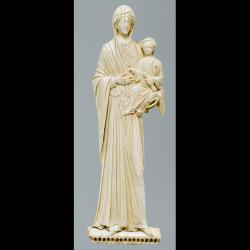Italo-Byzantine Columnar Mode
Members of the clergy had recently returned from the 1215 Fourth Lateran Council and the sculptural program resonates with Church Reform. It is possible that they had viewed the mosaics of the apse of Santa Maria in Trastevere and other Roman churches; might they also have seen the mosaics of Ravenna? The deployment of this mode begins with the overt reference to a Byzantine ivory image of the Virgin Mary Hodegetria which provided the model for the trumeau image in the south portal. The Byzantine Mother of God (Theotokos) has become the Gothic Mère Dieu. However, the most powerful expression of this mode of production comes in the Apostles of the central portal. There is little contrapposto here: figures stand four-square, mostly looking inward towards Christ, the Door. Drapery folds are broadly vertical, though occasionally cut through by strong diagonal swathes. Faces are serene, somewhat expressionless. There is a high level of sameness from one figure to the next: these are human beings cast in the same mold--the one provided by Christ, the Beau Dieu, at the center. This mode of production can also be found in the sculpture of the north west portal of Notre-Dame of Paris: it almost certainly reflects clerical intervention in the business of sculptural production

